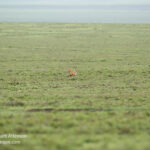Creating photos with an exaggerated sense of scale, where the sun or moon appears enormous, is a captivating technique. This effect, often referred to as “compression,” isn’t a Photoshop trick but a result of manipulating perspective using telephoto lenses and distance. This article explores how to achieve this stunning visual effect in your photography.
 alt text: A dancer poses on a beach with a large sun in the background.
alt text: A dancer poses on a beach with a large sun in the background.
The phenomenon of compression arises from the relationship between subject-to-camera distance and lens focal length. Longer lenses, such as telephotos, amplify this effect, making the background appear closer to the subject. This alters the perceived relative size, creating the illusion of a massive sun or moon. It’s not that the celestial body is actually larger; its apparent size relative to the subject is exaggerated.
 alt text: A comparison of photos taken with different focal lengths showcasing the effect of lens compression on the apparent size of the sun.
alt text: A comparison of photos taken with different focal lengths showcasing the effect of lens compression on the apparent size of the sun.
To effectively create this effect, a significant distance between the subject and the camera is crucial. Shooting on a flat plane, like a beach or salt flat, enhances the illusion. Experimenting with different focal lengths, starting with a 300mm lens and potentially adding extenders (1.4x or 2x) to increase the focal length further, allows for dramatic results.
 alt text: A silhouetted figure against a massive setting sun on a beach.
alt text: A silhouetted figure against a massive setting sun on a beach.
The greater the distance and the longer the lens, the larger the sun or moon will appear. However, shooting with extreme telephoto lenses presents challenges. Communication with the subject becomes difficult, precise focusing is essential, and the window of opportunity for capturing the ideal shot narrows as the sun’s position changes rapidly. Using Live View and high-speed shooting mode can assist with these challenges.
 alt text: A dancer performs in the desert with a huge setting sun in the background.
alt text: A dancer performs in the desert with a huge setting sun in the background.
Location also plays a significant role. Salt flats, like the Salar de Uyuni in Bolivia, offer exceptional opportunities due to their vast, flat expanse and reflective surface, further amplifying the compression effect.
 alt text: A person walks on the reflective surface of the salt flats with a large sun setting in the distance.
alt text: A person walks on the reflective surface of the salt flats with a large sun setting in the distance.
 alt text: A photographer lies on the ground with a long telephoto lens pointed towards the setting sun.
alt text: A photographer lies on the ground with a long telephoto lens pointed towards the setting sun.
 alt text: A diagram illustrating the relationship between distance, focal length, and the apparent size of the sun.
alt text: A diagram illustrating the relationship between distance, focal length, and the apparent size of the sun.
Capturing breathtaking images with a giant sun or moon involves understanding the principles of compression and utilizing the right equipment and techniques. Experimentation, patience, and a keen eye for perspective are key to mastering this powerful visual effect. Shooting during sunrise or sunset is recommended for optimal lighting and safety. Remember to protect your eyes when shooting directly into the sun.

